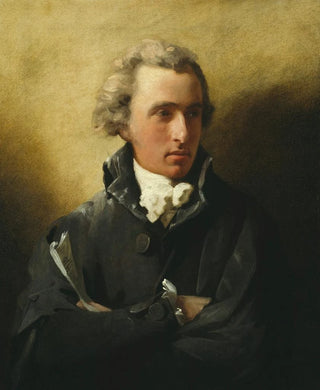Art print | Robert Brown de Newhall - Sir Henry Raeburn


View from behind

Frame (optional)
In the world of 18th-century painting, the art print "Robert Brown of Newhall" by Sir Henry Raeburn stands out for its psychological depth and visual intensity. This portrait, which captures the very essence of its subject, evokes a time when art served to immortalize prominent figures of society. The depiction of Robert Brown, an influential businessman of the era, is much more than a simple image; it is a living testament to the identity and social stature of an individual. Immersing oneself in this artwork invites the viewer to explore not only the face of the subject but also the history and values of a bygone era.
Style and uniqueness of the work
Raeburn's style is characterized by striking realism, meticulous attention to detail, and masterful use of light. In "Robert Brown of Newhall," the artist manages to create an atmosphere that is both intimate and solemn. The choice of colors, ranging from warm tones to darker shades, contributes to the emotional depth of the composition. The subject's slightly tilted posture and frank gaze foster a silent dialogue between him and the observer. Raeburn, a true master of the portrait, succeeds in transcending the physical aspect of his model to reveal their soul. This painting embodies the spirit of the Enlightenment, where the individual is placed at the forefront, and where the psychology of the character is carefully explored.
The artist and his influence
Sir Henry Raeburn, an emblematic figure of Scottish painting, knew how to mark his era with his innovative approach to portraiture. Trained in a vibrant artistic context, he skillfully combined tradition and modernity, influencing many artists who followed him. His work is distinguished by a capacity to capture not only the appearance of people but also their character and essence. Raeburn managed to give a voice to his subjects, elevating them to the rank of icons of their time. His impact on portraiture is not limited to Scotland; he also inspired generations of artists across Europe, who sought to imitate his style while

Matte finish

View from behind

Frame (optional)
In the world of 18th-century painting, the art print "Robert Brown of Newhall" by Sir Henry Raeburn stands out for its psychological depth and visual intensity. This portrait, which captures the very essence of its subject, evokes a time when art served to immortalize prominent figures of society. The depiction of Robert Brown, an influential businessman of the era, is much more than a simple image; it is a living testament to the identity and social stature of an individual. Immersing oneself in this artwork invites the viewer to explore not only the face of the subject but also the history and values of a bygone era.
Style and uniqueness of the work
Raeburn's style is characterized by striking realism, meticulous attention to detail, and masterful use of light. In "Robert Brown of Newhall," the artist manages to create an atmosphere that is both intimate and solemn. The choice of colors, ranging from warm tones to darker shades, contributes to the emotional depth of the composition. The subject's slightly tilted posture and frank gaze foster a silent dialogue between him and the observer. Raeburn, a true master of the portrait, succeeds in transcending the physical aspect of his model to reveal their soul. This painting embodies the spirit of the Enlightenment, where the individual is placed at the forefront, and where the psychology of the character is carefully explored.
The artist and his influence
Sir Henry Raeburn, an emblematic figure of Scottish painting, knew how to mark his era with his innovative approach to portraiture. Trained in a vibrant artistic context, he skillfully combined tradition and modernity, influencing many artists who followed him. His work is distinguished by a capacity to capture not only the appearance of people but also their character and essence. Raeburn managed to give a voice to his subjects, elevating them to the rank of icons of their time. His impact on portraiture is not limited to Scotland; he also inspired generations of artists across Europe, who sought to imitate his style while






